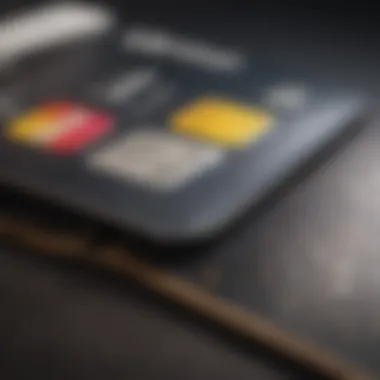Navigating Money Orders: Using Debit Cards Effectively


Overview of the Topic
Money orders have long been a reliable financial instrument in transactions, especially for those lacking access to traditional bank accounts. This form of payment provides a safe and secure method for sending money, often used for bill payments or transactions between individuals. Understanding how to navigate money orders, particularly through the use of debit cards, can streamline interactions in both personal and business contexts.
Challenges often arise when selecting the method to obtain a money order. Traditional options like cash or checks come with their set of limitations. Integrating debit card transactions into this process adds a convenient layer, yet it’s essential to comprehend the mechanics involved. By utilizing debit cards, users have the potential to access funds directly from their bank accounts without handling physical cash. This is both practical and often promotes greater security over carrying cash.
Key Benefits and Implications
- Convenience: Using a debit card to purchase a money order frequently simplifies the process. There is no need to withdraw cash beforehand, reducing unnecessary trips to ATMs or banks.
- Security: Funds are drawn directly from a bank account, which can be safer than handling physical cash. Moreover, the chances of losses due to theft are diminished.
- Accessibility: People without traditional banking services can still benefit from money orders when combined with debit cards, making this method an inclusive financial tool.
It is, however, crucial to evaluate the possible fees associated with obtaining money orders using debit cards. Different issuers may impose varying charges, which could diminish the overall benefit. Understanding these details will help users make well-informed choices regarding their financial activities.
Understanding Money Orders
Understanding money orders is paramount when exploring their use, especially in the context of making transactions with a debit card. This section establishes a foundational knowledge of money orders, which is essential for any individual looking to navigate through financial options effectively. Unlike many other financial instruments, money orders offer a unique blend of security and convenience, making them a relevant choice in various scenarios.
Definition and Purpose
A money order is a payment order for a pre-specified amount of money. It is sold at various institutions, such as post offices and banks, and may be used to pay bills or make purchases. The purpose of a money order is to provide a secure method of payment that does not require a bank account. When someone purchases a money order, they pay the full amount upfront in cash or using a debit card.
Many people utilize money orders when they need to make a payment and do not want to use cash or check. Common scenarios include sending money via mail or paying rent. The guaranteed payment offered by a money order is reassuring for recipients since it decreases the risk of bounced checks or incomplete payments.
Difference Between Money Orders and Checks
Understanding the differences between money orders and checks is crucial. A check is a personal document that instructs a bank to pay a specific amount from one account to another. In contrast, a money order is prepaid and acts like cash. Here are some key distinctions:
- Guaranteed Payment:
Money orders guarantee that the funds are available at the time of purchase. Checks depend on the sender having sufficient funds in their account. - Identification:
Money orders can often be purchased without a bank account or credit check. With checks, a linked bank account is mandatory. - Limitations on Amount:
Money orders generally have a maximum limit on the amount you can purchase at one time, which is often set by the issuing authority. In contrast, checks can be written for virtually any amount within the account’s balance.
Common Uses of Money Orders
Money orders serve numerous individual and business purposes. Recognizing their applications can help users take advantage of their benefits. Some common uses include:
- Paying Bills:
Individuals may use money orders to pay utilities or other bills, especially when they prefer not to disclose bank account information. - Sending Money:
Money orders are a preferred method for sending funds through the mail, providing a safer alternative to cash. - Purchasing Goods:
Money orders can be used to purchase items from specific retailers that accept them as a form of payment.
In summary, recognizing money orders' definition, core distinctions from checks, and common usages establishes a significant understanding that can aid both novices and experienced users in enhancing their financial strategies.
Debit Cards Explained
Understanding debit cards is essential within the context of acquiring money orders. Their structure offers users a straightforward way to access funds from their bank accounts without the need for checks or cash. This section delves into the process and advantages of debit cards, comparing them with credit cards, and highlighting their significance in financial transactions.
What is a Debit Card?
A debit card is a payment card that draws money directly from a consumer's bank account when making a purchase. Unlike credit cards, which allow users to borrow funds up to a certain limit, debit cards rely on existing balances. This means that spending is limited to the funds available in the account. Debit cards are commonly issued by banks and credit unions and can be used for various transactions, such as ATM withdrawals and point-of-sale purchases.
Debit Card vs. Credit Card
The primary distinction between a debit card and a credit card lies in the source of funds. With a debit card, the amount spent is instantly deducted from the associated bank account. In contrast, a credit card allows users to spend on credit, meaning they can pay off the balance later, usually accruing interest if not settled within a grace period. Here are key differences summarized:
- Source of Funds: Debit uses existing funds; credit uses borrowed money.
- Fees and Interest: Debit cards typically have lower fees; credit cards may incur interest charges if balances are not paid in time.
- Credit Score Impact: Debit cards do not affect credit scores; credit cards can influence credit ratings based on usage and payments.
Advantages of Using Debit Cards
Using a debit card comes with several benefits that make financial transactions easier and safer. Some advantages include:


- Instant Access: Funds are available immediately; no waiting for approvals.
- Control Over Spending: Limits overspending since it draws from the account balance.
- Reduced Fees: Often, debit card transactions have lower fees compared to credit card transactions.
- Simplicity and Convenience: Easy to carry and use, eliminating the need for cash or checks.
Moreover, when purchasing money orders, debit cards can provide a quick way to complete the transaction without carrying physical cash, enhancing security and convenience. This efficiency aligns well with the needs of individuals dealing with money orders.
Acquiring Money Orders Using Debit Cards
Acquiring money orders using debit cards is a practical way to access these financial instruments. This process allows individuals to use the funds already available on their debit cards, minimizing the risk associated with personal checks or carrying cash. Understanding different methods for obtaining money orders enhances awareness and helps consumers make better choices depending on their circumstances. Additionally, knowing where and how you can purchase money orders can save time and effort.
In-Person Transactions
In-person transactions are a preferred method for many people who want to acquire money orders. These transactions offer direct interaction, which can alleviate concerns related to security and authenticity.
Retail Outlets
Retail outlets provide convenience for those looking to buy money orders. Almost every community has a nearby store like Walmart or convenience stores, which often offer this service.
The accessibility of retail outlets is a key characteristic. Customers can household errands and obtain a money order without making a dedicated trip to a bank. This makes it a beneficial choice for busy individuals. However, it is important to note that many retail outlets may charge higher fees for the service compared to banks.
Advantages of this method include the proximity and flexibility offered by such locations. One disadvantage could be potential variations in fees and terms depending on the specific outlet.
Post Offices
Post offices also issue money orders, which adds to their relevance in this context. They are a reliable option given their established trust and reputation in providing financial services.
A notable characteristic of post offices is their consistent fee structure. Typically, prices do not fluctuate as much as those at retail outlets, which can be beneficial for those budgeting their expenses. This location is particularly popular among customers who want a government-backed option.
They do have some downsides, such as limited hours of operation compared to retail stores. Additionally, during peak times, wait times can be lengthy.
Financial Institutions
Obtaining money orders from financial institutions is another reliable option. Banks and credit unions frequently provide this service, which adds a layer of security.
One key advantage of acquiring a money order at a financial institution is often lower fees compared to other locations. Furthermore, the transactions tend to be straightforward because staff members are trained to assist customers in financial processes.
However, not every branch will issue money orders, so it is essential to call ahead or check online. This can especially pose a challenge for customers who do not have an account with that institution, as policies may vary.
Online Money Order Services
Online money order services have seen an increase in use due to the convenience they offer. These services allow users to order a money order from the comfort of their home. Online platforms accept payments via debit cards, making transactions seamless.
This method eliminates many logistics involved in in-person purchases. Individuals can complete the transaction when it suits them without traveling to a physical location. However, it is crucial to ensure the legitimacy of the site used, as scams can occur in the digital space.
Mobile Money Apps
Mobile money apps are redefining how we think about transactions. Some apps allow users to purchase money orders using their debit cards directly through their smartphones. This flexibility caters to those who prefer digital solutions.
An advantage of using mobile apps includes real-time updates and notifications related to the transaction status. This technology also often provides easy tracking features for one’s finances. However, users need to consider the security features of these apps to safeguard their information.
Fees and Charges Associated with Money Orders
Understanding the fees and charges associated with money orders is critical when navigating financial transactions. Money orders, while considered a safe alternative to checks, are not free. Knowing the costs will help you make informed decisions and maintain control over your budget. This section will explore various fee structures and potential hidden costs, providing insight into how these elements can impact your overall expenditure.
Understanding Fee Structures


Fees related to money orders can vary significantly depending on the provider. Generally, the fee structure may include:
- Purchase Fees: This is the primary cost incurred when obtaining a money order. Retailers or banks often charge a flat fee, which can range from a couple of dollars to a higher amount depending on the order’s value. The fee might also vary based on whether you are a customer of the institution or a non-customer.
- Processing Fees: Some institutions may charge additional processing fees, especially if the money order is used for specific purposes or via particular methods, such as online or mobile applications.
- Cashing Fees: If you plan to cash a money order, it is essential to be aware of the fees that may apply. Cashing locations, which include some banks or check-cashing stores, often impose fees that can vary widely.
It can be beneficial to compare rates from various providers to ensure you are getting the best deal. A small difference in a fee may save you money over time, especially if you frequently use this service.
Potential Hidden Costs
While initial fees may seem straightforward, hidden costs can accrue and impact your financial plans. Consider the following:
- Inactivity Fees: Some providers impose inactivity fees if the money order is not cashed within a specific time frame. If you hold onto a money order for too long, you might inadvertently incur these additional charges.
- Lost Money Order Fees: If a money order is lost or stolen, reissuing it can come with a fee. Furthermore, the process to claim a lost money order might involve extra steps and time.
- Currency Conversion Fees: If you are using a money order in a different currency, check for any conversion fees that might apply. This can add to the overall cost of your transaction, especially if the exchange rate is not favorable.
"Understanding all associated costs with money orders is essential for personal financial literacy. Ignoring these could lead to unforeseen expenses that impact your budget."
By examining both clear charges and hidden costs, individuals can better assess the efficiency of using money orders compared to other payment methods. Staying vigilant and informed empowers users to manage their funds effectively.
Security Considerations
Security is a crucial element when it comes to using money orders, especially when transactions are carried out with debit cards. Understanding potential risks and having knowledge of effective protective measures is necessary for anyone involved in these financial activities. This section digs into the various aspects surrounding security, providing insights into how to safeguard against fraud and other vulnerabilities.
Protecting Against Fraud
The risk of fraud is a prevalent concern in financial transactions. When it comes to purchasing money orders with debit cards, it is essential to be informed about how to mitigate these risks. Many individuals may not realize that their financial information can be targeted if they are not careful.
Here are some key practices for limitation fraud:
- Use Trusted Outlets: Always conduct transactions through trusted retailers or financial institutions. For instance, both Walmart and local bank branches offer reliable environments for such purchases.
- Monitor Accounts Regularly: Keep a close eye on your bank statements. Regular reviews can help identify unauthorized transactions quickly and take appropriate action.
- Be Wary of Scams: Always be cautious of unsolicited offers or messages requesting personal information or payment details. Scammers often use deceptive tactics to gain access to your financial data.
Implementing such measures will bolster your defenses against potential fraud, ensuring that your transactions remain secure.
Insurance on Money Orders
Understanding insurance related to money orders is equally important. In case of loss or theft of a money order, having insurance coverage can save you from financial loss. Unfortunately, many people overlook this aspect, assuming that money orders are always safe.
Consider the following points regarding insurance:
- Checking for Coverage: Always inquire if the provider offers any insurance or guarantees for the money orders. Some institutions may provide policies that protect consumers against losses.
- Document Everything: Keep receipts and records of every transaction. In the event of a problem, having proof is invaluable. It facilitates any claims you may need to file regarding insurance coverage.
- Understand Claims Process: Familiarize yourself with the claims process related to insurance coverage for money orders. This knowledge can expedite the resolution time in case a financial event occurs unexpectedly.
Having a comprehensive understanding of insurance on money orders can provide peace of mind. This insight not only brings assurance but also positions one to act swiftly if issues arise that involve fraud or loss.
Protecting your financial transactions and having adequate information on insurance can lead to a more confident and secure experience when using debit cards for money orders.
Alternatives to Money Orders
Finding reliable ways to transfer money is essential in today's financial landscape. While money orders are a common choice, it is important to consider alternatives that may better suit your needs. Alternatives to money orders can provide similar features with sometimes lower fees or enhanced convenience. Understanding these options allows you to make informed decisions on how to handle your transactions effectively.
Wire Transfers
Wire transfer is one option that offers a direct and speedy way to send funds from one bank account to another. Unlike money orders, which require a physical purchase and can take longer to process, wire transfers allow for nearly instantaneous transfers. This can be particularly beneficial for urgent payments or international transactions.
Some benefits of wire transfers include:
- Speed: Transfers can happen within hours or even minutes.
- Security: Conducted through banks, these are generally secure and traceable.
- Convenience: Only requires bank account information to initiate.


However, it is important to be aware of potential fees associated with wire transfers, as they can vary significantly depending on the banks involved. Not all banks offer the same terms and it's wise to compare different options before proceeding.
Cash Transactions
Cash transactions remain a traditional method that avoids many of the complexities associated with electronic transfers. Using cash can be particularly helpful for small purchases or quick payments. There are no fees, unlike money orders, and no waiting period involved. In some cases, cash may offer anonymity that digital transactions do not.
However, cash transactions have drawbacks:
- Security Risks: Carrying large amounts of cash may pose a risk of theft.
- Limitations: Not suitable for large sums or remote payments.
- No Record: Cash transactions do not leave a paper trail, which can complicate proof of payment.
Electronic Payment Systems
Electronic payment systems have gained traction as a modern alternative. Options such as PayPal, Venmo, and Zelle offer quick, digital methods to transfer money to individuals or businesses. These platforms allow for seamless transactions without the need for physical money. They also provide easy-to-use mobile apps that simplify the process, making payments more accessible.
Benefits of electronic payment systems include:
- User-Friendliness: Most apps are designed for quick and intuitive use.
- Versatility: Can be used for various transactions, from bills to personal payments.
- Record Keeping: Automatically tracks your transactions, providing a clear financial history.
Despite their benefits, electronic payment systems can come with fees depending on the service and the type of transaction. Additionally, user accounts must be secured to protect against fraud. Understanding these systems helps you choose wisely based on your specific financial needs.
Considering alternatives to money orders allows for greater flexibility and can enhance your overall transaction experience. Whether you opt for wire transfers, cash transactions, or electronic payment systems, it's critical to weigh the pros and cons of each method.
Best Practices for Using Debit Cards to Purchase Money Orders
When using debit cards to acquire money orders, it is critical to follow best practices to ensure smooth transactions and minimize potential risks. This section outlines effective strategies for managing your purchases of money orders through debit cards, focusing on transaction limits, staying informed about fees, and keeping accurate records.
Reviewing Transaction Limits
Understanding transaction limits is fundamental when purchasing money orders with a debit card. Many financial institutions impose these limits, which may vary by account type and institution. Usually, there are daily and weekly limits on the amount that can be withdrawn or used in purchases.
Before proceeding with a money order purchase, it is advisable to verify your debit card transaction limit. This can avoid the frustration of denied transactions when attempting to acquire a money order that exceeds your limit. Additionally, contacting your bank or credit union before your transaction can provide clarity on any temporary increases in limits, especially if a large transaction is anticipated.
Staying Informed About Fees
Fees associated with money orders can add significant costs to your transactions. Schools, stores, or services issuing money orders often charge fees that vary widely based on the amount of the money order and the location. Staying informed about these fees is essential for budget management.
When using a debit card, some banks may also charge a fee for the transaction itself. Make sure to research the fees associated with the money order provider and your bank. This can help in avoiding unexpected charges that may arise during your purchase. Always inquire about any hidden fees that could be charged once the transaction is complete.
Keeping Records of Transactions
Maintaining accurate records of your transactions involving money orders is important for several reasons. First, it allows for better personal financial management. By tracking each transaction, you can identify spending patterns and better allocate your budget.
Second, having detailed records can assist in dispute resolution should any issues arise with the money order or the transaction. This is especially critical in the event of fraud or if a money order is lost. Keeping receipts and digital records can provide evidence of your purchase, making it easier to resolve disputes efficiently.
Finale
Understanding how to effectively use debit cards for purchasing money orders is essential for anyone navigating today’s financial environment. This article has outlined various facets of this process, illuminating benefits, considerations, and best practices.
Summarizing Key Points
To encapsulate the main concepts discussed:
- Definition of Money Orders: Money orders serve as a safer alternative to cash and a more reliable payment method than personal checks.
- Using Debit Cards: Debit cards facilitate money order transactions, allowing quick payments without requiring physical cash.
- Acquisition Methods: Money orders can be obtained in-person or online, each method having its own advantages.
- Fees and Security: It is important to be aware of potential hidden costs and security measures to protect against fraud.
- Alternatives: Knowing the alternatives to money orders can provide flexibility in financial transactions.
- Best Practices: Staying informed about transaction limits, monitoring fees, and keeping records can enhance the experience.
Future Trends in Money Orders and Payments
Looking ahead, the landscape of money orders and payments is likely to evolve substantially.
- Digital Payment Innovations: As digital payment systems become more prevalent, the methods of obtaining money orders may become more streamlined and integrated with banking apps.
- Increased Security Measures: Future advancements may include enhanced security features that protect users against fraud, such as biometric authentication for transactions.
- Shift in Consumer Preferences: A broader trend towards contactless payments may reduce the reliance on traditional money orders.
Overall, staying updated on these trends will be critical for individuals utilizing money orders regularly. The financial landscape is dynamic, and adapting to these changes can lead to a more efficient and secure transaction process.



